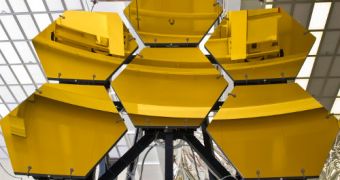Earlier this week, the NASA James Webb Space Telescope (JWST) program achieved an important milestone, when the first batch of segments that will go on to form the spacecraft's main mirror managed to successfully pass cryogenic tests.
The assessments were designed in such a way that they mimicked the condition the instrument will be subjected to when it reaches its destination in space. The JWST is destined for the L2 Lagrangian point, where it will remain in the same relative position to the Earth-Sun-Moon system.
It will turn a massive heat and radiation shield towards the three bodies, so as to prevent any stray light from entering its extremely sensitive detectors. It will then use an 18-segment main mirror to scout the earliest days of the Universe.
The telescope – destined to replace the Hubble – will be capable of seeing back extremely far back in time, to an epoch when the Universe was just a couple hundred million years old. In order to be able to do that, its mirror needs to be quite literally perfect.
The mirror is constructed of 18 hexagonal segments, each of which is polished to a precision level that is nearly unfathomable. Only a few atoms in thickness separate these smaller mirrors from perfection.
In order to determine how exposure to the harsh conditions of space would influence these segments, experts at the NASA Marshall Space Flight Center (MSFC) in Huntsville, Alabama, put them through their paces in the X-ray and Cryogenic Facility.
This installation can emulate the harshest conditions the mirrors will ever face. During the tests, the segments were cooled down to as much as minus 379 degrees Fahrenheit, NASA engineers say.
Given the large number of segments, the mirror will be tested in groups. The first 6 small mirrors proved able to withstand their future environment, and another batch of 6 is scheduled to arrive at the MSFC in late July.
The third and final batch will arrive in Alabama later in the year. Once all three batches are deemed flight-worthy, experts will move on to integrating them with the rest of the observatory's bus.
“Each mirror segment measures approximately 4.3 feet (1.3 meters) in diameter to form the 21.3 foot (6.5 meters), hexagonal telescope mirror assembly critical for infrared observations,” NASA says in a press release accompanying the announcement.
“Each of the 18 hexagonal-shaped mirror assemblies weighs approximately 88 pounds (40 kilograms). The mirrors are made of a light and strong metal called beryllium, and coated with a microscopically thin coat of gold to enabling the mirror to efficiently collect infrared light,” the statement adds.

 14 DAY TRIAL //
14 DAY TRIAL //